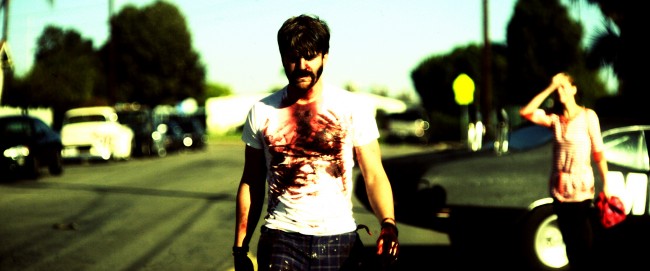Bellflower
Mumblehorror

Review by Robert Patrick
The pulpy, unfiltered theme of the apocalypse bares its fangs in director Evan Glodell’s caustic and unhinged “Bellflower”. An uneasy feeling crawls over the film like the legs of a mantis, as things go from conspicuously unsound to hysterically sociopathic, before the movie finally collapses from exhaustion. “Bellflower” is more about the fallout of the mind, more than, in a literal sense, the nuclear eradication of the world – though the two, one could argue, go hand-in-hand.
The movie is about the dystopian, high-fructose world of scruffy-mawed twenty-somethings on the precipice of total erosion. Best friends Woodrow and Aiden, played by Evan Glodell and Tyler Dawson, are two bored, volatile young men who don’t even have a screw to lose. Their barren, red dirt minds are preoccupied with a vehement fiction where they are, in accordance with their violent passions, post-apocalyptic madmen akin to the leather inundated “Mad Max.” The two batty brothers-in-arms find ways to assemble makeshift flame-throwers, in their backyards, in order to spray ropes of fire at scarecrows. They shoot sawed-off shotguns at propane tanks, salivate over the results of their bombastic hobby of uninhibited destruction, and scramble any would be morality in the process. I can imagine these two are what Sid Phillips, the action-figure torturing tyke from Pixar’s “Toy Story,” grew up to be like in adulthood.
When the dopey duo aren’t eviscerating objects with their sadistic homemade weapons, they are, quite irresponsibly, picking up women at sketchy bars around town. One evening in particular, Woodrow meets a girl with a shock of blond hair, that’s propped up in wishbone like pigtails, named Milly (Jessie Wiseman). The two challenge each other, on who’s more spontaneous, and they end up partaking in some barbed activities that ring reminiscent of Sid and Nancy. Our anti-hero even has a car, that slow-drips whiskey out of its dash, that, if one really wants to understand, would be similar to the Mach-5 if Charles Bukowski invented it. Woodrow’s salty, unchained and spurious relationship with Milly represses his alternate ego as a post-apocalyptic anti-hero, exponentially, until things go awry later in the film. The grease-slacked, vacuous, and self-indulgent components of Glodell’s film desire to be compared to a Bret Easton Ellis novel on electroshock therapy. Because Glodell decided to construct a Frankenstein camera, in an effort to make his film look as distinguished as possible, he took parts from everything from a Macbook to a car inverter in order to charge, manipulate, and conduct his film in the most guerrilla style possible. The outcome is a milky, atmospheric, smoke-saturated project that looks as though a stained glass window, instead of a conventional camera lens, was used to shoot this movie. This sort of filthily enigmatic approach worked in films such as Dominic Murphy’s “White Lightnin'”; here, in the tainted world of Evan Glodell, the yolky-kaleidoscope of deep reds and off-yellows is just as applicable in presenting a similarly destitute feel. And even though the saturation of the picture is nauseating – at times the print looks as though it was dunked in Easter egg dye – by the end of the movie you realize, instinctively, that the mood would have been entirely innocuous if not for the punchy colorization.
For as jarring and feral as “Bellflower” is, the movie still has, with its syrupy dialogue and sloth like pacing, the soul of a mumblecore film – that’s wrapped in the body of a Nine Inch Nails video. Candied whispers and winsome exchanges, fueled by bad self-esteem and staccato dialogue, are typically trademarks of mumblecore films. Glodell’s picture, by comparison, replaces the coos and sweet-nothings with rusty and tyrannical syllables. Everyone’s conversations in “Bellflower” are lazily downfeathered and occasionally giggle-hearty, giving the idea that, despite their perversity, there is some humanistic and minimal qualities beneath their deplorable outer shells – but in reality there is little sign of emotional dexterity in these people’s tongues or brains. Because Glodell’s opus is gooey, curdled, and waxy, it is hard to have affection for the movie as a form of entertainment; “Bellflower” is more of an experience in patience and will, morbid curiosity and tension than it is in positive stimulation. Because of its intense, scribbled composition, “Bellflower” is worthy of anyone within an earshot of being interested in an unconventional film bordering on pure megalomania and unbridled lunacy.
